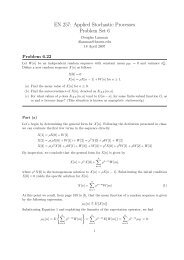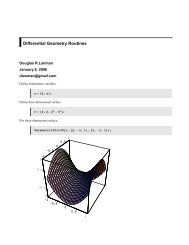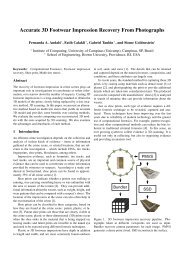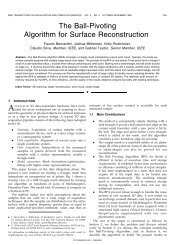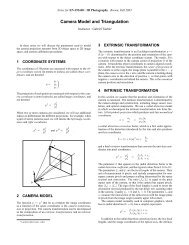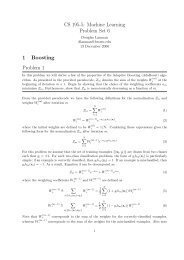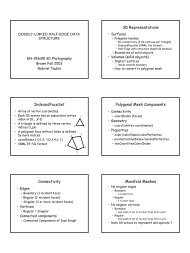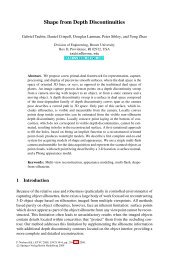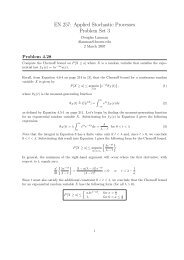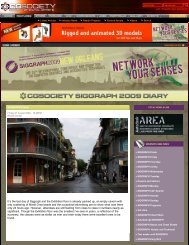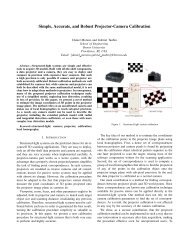Slides on Mesh Simplification - TAUBIN GROUP @ Brown
Slides on Mesh Simplification - TAUBIN GROUP @ Brown
Slides on Mesh Simplification - TAUBIN GROUP @ Brown
Create successful ePaper yourself
Turn your PDF publications into a flip-book with our unique Google optimized e-Paper software.
3/30/2008Surface Simplificati<strong>on</strong>and Optimizati<strong>on</strong>Multiresoluti<strong>on</strong> Representati<strong>on</strong>sSurface Simplificati<strong>on</strong>• Algorithms to reduce the number ofvertices and faces while preservinggeometric approximati<strong>on</strong>ENGN2911I3D Photography and Geometry Processing<strong>Brown</strong> Spring 2008Gabriel TaubinSurface Simplificati<strong>on</strong> Methods• Vertex Clustering– Rossignac-Borrel 93•Vertex Removal– Schroeder-Zarge-Lorensen 92• Edge Collapse– Garand Heckbert 97Vertex Clustering• Vertex Clustering– Quantize coordinates wrt Bbox– Identify vertices with same coordinates– Remove empty pytrianglesVertex Clustering Algorithm– Quantize coordinates wrt Bbox– Assign a new vertex index to eachoccupied cell– Determine coordinates of new vertices– C<strong>on</strong>struct newVertex index look-up table– Replace vertex indices in coordIndex– Remove empty triangles fromcoordIndexVertex Clustering•Advantages– Simple to implement– Works <strong>on</strong> large scenes with multipleobjects– No manifold restricti<strong>on</strong>• Disadvantages– Produces n<strong>on</strong>-manifold meshes– Quality of simplified model is not verygood1
3/30/2008Vertex Removal•Vertex Removal– Choose “removable” vertex– Remove vertex–Triangulate holeVertex Removal•Advantages– Better surface quality– Maintains manifold structure• Disadvantages–Complexity– Multiple hole triangulati<strong>on</strong>sVertex Removal Algorithm 1• Put all “removable” vertices in priorityqueue according to “removal error”• While queue is not empty– Delete minimum i vertex from queue– Remove vertex and triangulate hole– Remove all incident vertices from the queue,recompute “removal error”, re-insert in queue• Need dynamic data structuresVertex Removal Algorithm 2• Put all “removable” vertices in priorityqueue according to “removal error”• Choose an “independent set” of vertices– Initialze set to empty– While queue is not empty• Delete minimum vertex from queue• If vertex is independent of vertices in set– Add vertex to set• Remove all vertices in independent set at<strong>on</strong>ce, in any order• Can use IndexedFaceSet as output DSEdge Collapse• Identify endpoints• Determine vertex positi<strong>on</strong>• Remove incident triangles• Which edges to collapse ?•In which order ?Collapsing Unc<strong>on</strong>nected Vertices• Identify pair of vertices• Determine vertex positi<strong>on</strong>• Which pairs of vertices to collapse ?• In which order ?2
3/30/2008Edge Collapse Algorithm 1• Put all “collapsible” edges in priority queueaccording to “removal error”• While queue is not empty– Delete minimum edge from queue– Collapse edge• Identify vertices• Delete incident edges– Remove all incident edges from the queue,– Determine if “collapsible”, recompute “removalerror”, re-insert in queue• Need dynamic data structuresEdge Collapse Algorithm 2• Put all “collapsible” edges in priority queueaccording to “removal error”• Choose an “independent set” of edges– Initialze set to empty– While queue is not empty• Delete minimum edge from queue• If edge is independent of all edges in set– Add edge to set• Remove all edges in independent set at<strong>on</strong>ce, in any order• Can use IndexedFaceSet as output DSGarland-Heckbert• Each vertex has a 4x4 Symmetricmatrix Q which initially measures thesquare distance from a point to thenormal plane• When two vertices are merged thematrices are added• New matrix measures the sum of thesquare distances to N planesRemeshing• Adaptive resampling• Semi-regular c<strong>on</strong>nectivity– Subdivisi<strong>on</strong> surfaces• Inverse of Simplificati<strong>on</strong> ?• Retiling [Turk 92]Dynamic c<strong>on</strong>nectivity• Kobbelt et. al. Eurographics 2000– 2 Emin < Emax– Collapse all edges shorter than Emin–Split all edges l<strong>on</strong>ger than Emax– Flip edges to equalize vertex valence– Smooth– Iterate until all edges have lengthbetween bounds–Details?Dynamic c<strong>on</strong>nectivity3
3/30/2008Boundaries and Ridges• How to detect ?•How to handle– in simplificati<strong>on</strong> algorithm ?–in optmzat<strong>on</strong> optimizati<strong>on</strong> algorthm algorithm ?– In remeshing algorithm ?– In smoothing algorithm ?Adaptive Triangle Subdivisi<strong>on</strong>• Mark vertices of edges that need tobe refined• Create a new vertex at the midpointof each edge with 2 marked vertices• Quadrisect each triangle with 3marked vertices• Bisect each triangle with 2 markedvertices• Keep other triangles4




